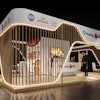EuroTier represents the largest European and world innovations market for process engineering machinery and equipment, farm inputs, management and software, animal housing installations, and animal housing and barn construction for the entire world of professional animal farming.
As usual, very large numbers of innovations were submitted for EuroTier in 2014. The many highly interesting new and further developments and substantial improvements of already known products show above all that the innovative thrust of manufacturers in the field of animal farming remains at a very high level. Crucial factors influencing the selection of the award-winning innovations and products are their significance for practical work and animal welfare, and their impacts on operating and labor management, the environment and the energy situation. Any impacts that facilitate work and improve work safety are also taken into consideration in the decisions on the awards. All together, 270 innovations from home and abroad were submitted to EuroTier 2014.
Alongside the award-winning innovations, the list of company innovations in the DLG Innovations Magazine will include products that are already known on the market, but are new for the respective company.
The innovative products that win a Gold or Silver Medal at EuroTier 2014 have not previously been exhibited and/or presented with an award at any other major trade fair or international show. The Gold and Silver Medal winning articles must be fully operable at the time of the trade fair and be available on the market at the latest in 2015. The award-winning products thus represent an ideal guide for all those visitors to EuroTier who are specifically looking out for innovations and thus help them to make the most efficient use of their time at the exhibition.
The 13 sectors from which the largest numbers of products were proposed for awards this year naturally include the classics, such as machinery and equipment for keeping and feeding for pigs and for cattle, as well as farm inputs and the machinery and equipment for using these inputs. However, there were also many submissions relating to the fields of management and software, machinery and equipment for dung and solid and liquid manure, animal housing and barn construction, machinery and equipment for milking and refrigeration, climate control and environmental technology, feed storage and feed production. There were also submissions for newer fields such as aquaculture again this year.
Overall, the Gold and Silver Medals awarded at EuroTier 2014 reflect the bandwidth of those sectors within which the field of management and software has become steadily more important over the years. This year the areas of machinery and equipment for milking and refrigeration, management and software, animal housing and barn construction, as well as machinery and equipment for pig keeping proved to be particularly innovative. Furthermore, it has become apparent that highly innovative solutions are conceived and developed not only for the typical animal species such as cattle, pigs and poultry, and that comfortable occupational safety can also be innovative.
Trends in pig keeping
Two findings have emerged in the sector of pig keeping this year. On the one hand keeping systems and their design can be fundamentally questioned and as a result it is possible to come up with completely new concepts. On the other hand it is becoming evident that the animal itself can be actively involved in shaping its keeping conditions.
Furthermore, some technical solutions that are offered are characterized in particular by process engineering approaches to improve pen cleaning in all “piggery areas,” to facilitate work in connection with transport tasks, to achieve more complete piggery hygiene, and to increase the service life of the machinery and equipment used and the keeping installations. In the feeding sector great value is still attached to reliable, more durable and improved feeding technology. The production of homogeneous feed mixes and the development of new feed and nutrient sources are important here.
Trends in cattle keeping and milking technology
Innovative developments in the sector of cattle keeping and milking technology will be on show at this year’s EuroTier as well.
With the aim of improving or optimizing feeding, both machinery and equipment for more expert silage making and feeding systems for dispensing more homogeneous feed rations will be on show.
Solutions have been developed for calf keeping that not only substantially improve the hygiene in the area of calf feeders, but are also able to ensure uninterrupted calf management from the time of birth and after. Furthermore, exhibitors show that even in an area such as dung removal technology, there is still potential for more individual operation of stationary dung removal facilities. In the case of mechanical milk extraction it is clear that innovations in modern milking machinery and equipment have by no means been fully exploited yet and that forward-pointing further developments are possible in the areas of gentle milking and udder health, as well as in hygiene and disinfecting.
In addition, this year’s EuroTier bears evidence to the fact that not only are highly innovative solutions being developed for the classic dairy animal, leading to essential improvements in working and hygiene conditions, but also that these new approaches are substantially improving work performance.
Trends in management and software
The trend in the areas of management and software is towards comprehensive system solutions, which alongside the automatic, wherever possible, collection, documentation and assessment of individual animal parameters and operating data, also provide more indications of any weaknesses in the management and derive approaches for optimizing the conditions. Furthermore, the forward-looking development targets cross-sectoral approaches to farm work that suspend the boundaries between farmyard and field operations, so that complex farm processes can be mapped, documented, steered and evaluated using software.

















